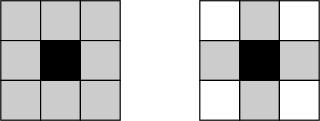On a regular 2D grid of pixels, there are essentially two possibilities to look at the neighborhood of a given pixel (in black below), or pixel connectivity: the 8-pixel connectivity (left, or Moore neighborhood), and the 4-pixel connectivity (right, von Neumann neighborhood). Four- and eight-adjacencies are other common terms.

The first one gives the same weight to all eight surrounding pixels, the second considers that the North, East, South, West gray pixels are closer (distance 1) than the ones in the corners (distance $\sqrt{2}$). Indeed, there are topological reasons. One is based on the $\ell_\infty$, $\max$ or Chebyshef distance, the other on the $\ell_1$, Taxicab or Manhattan distance.
Which regions are connected, how to design filters, are question with a different answer, and different results (see for instance 4-Neighbour vs. 8-Neighbour Graph Models of an Image).
The two $3\times 3$ Laplacian kernels are two possibilities in discretizing the continuous Laplacian along the two above options, while keeping integer values, useful with integer valued-pixels.

